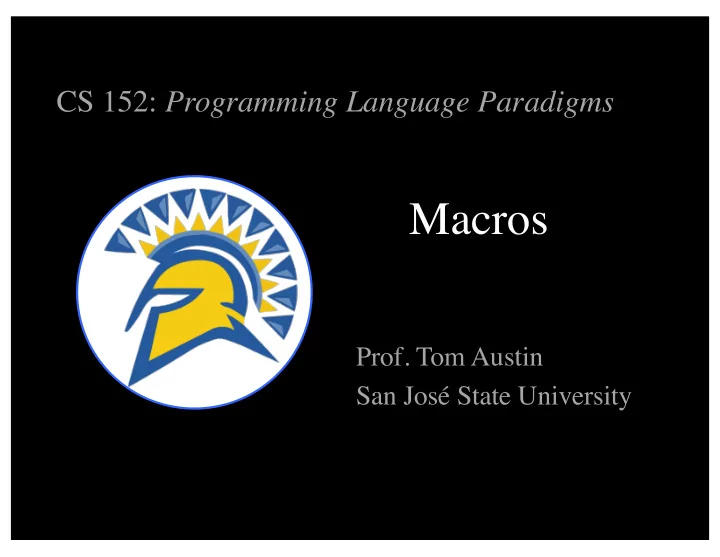

CS 152: Programming Language Paradigms Macros Prof. Tom Austin San José State University
Creating control structures with Lambdas (in class)
Redefining if expressions (define (my-if c thn els) (cond [(and (list? c) (empty? c)) els] [(and (number? c) (= 0 c)) els] [(and (boolean? c) (not c)) els] [else thn]))
Redefining if expressions (my-if #t 1 0) ;; returns 1 (my-if 1 1 0) ;; also returns 1 (my-if #f 1 0) ;; returns 0 (my-if '() 1 0) ;; also returns 0 (my-if #t (displayln "true") (displayln "false"))
Why didn't this approach work?
Scheme uses eager evaluation. • Arguments are evaluated first • Function body is evaluated second • In our example, we need to evaluate arguments lazily – that is, only when they are needed
Macros allow us to change the behavior of our language as we need.
What is a macro? • macroinstruction. • A rule or pattern that specifies how an input sequence should be mapped to a replacement sequence .
Text Substitution Macros • Work by expanding text. • Fast, but limited power. • Example: – C preprocessor
A Review of Compilers Lexer/ source tokens Parser code Tokenizer Abstract Compiler Interpreter Syntax Tree (AST) Machine code Commands
Some variants work at the token level, but the concept is the same. expanded Pre- Lexer/ source tokens code Parser processor Tokenizer code Abstract Compiler Interpreter Syntax Tree (AST) Machine code Commands
Writing swap in C (in class)
C preprocessor example #define PI 3.14159 #define SWAP(a,b) {int tmp=a;a=b;b=tmp;} int main(void) { int x=4, y=5, diam=7, circum=diam*PI; SWAP(x,y); }
int main(void) { int x=4, y=5, diam=7, circum=diam*PI; SWAP(x,y); P } r e p r o c e s s o r int main(void) { int x=4, y=5, diam=7, circum=diam*3.14159; {int tmp=x;x=y;y=tmp;}; }
Syntactic macros • Work on abstract syntax trees • From the Lisp/Scheme family – Lisp programs are ASTs • Powerful, but expensive
Macro expansion process Abstract Abstract Macro Syntax Tree Syntax Tree Expander (AST) (AST) Essentially a source-to-source compiler
Many macro systems suffer from inadvertent variable capture. Let's look at an example…
Accidental Capture Example (in class)
Hygiene Hygienic macros are macros whose expansion is guaranteed not to cause the accidental capture of identifiers .
Macros in Scheme • Scheme is noted for its powerful (and hygienic) macro system. • Is it needed? Aren't lambdas enough?
(define (swap x y) (let ([tmp x]) (set! x y) (set! y tmp))) (let ([a 7][b 3]) (swap a b) (displayln a) What is the result? (displayln b))
Pattern Based Macros • Preserves hygiene • define-syntax-rule – matches the given pattern – transforms code following the specified template • define-syntax – allows multiple patterns – supports a variable number of arguments (using the … syntax)
( define-syntax-rule (swap x y) (let ([tmp x]) (set! x y) (set! y tmp))) (let ([a 7][b 3]) (swap a b) (displayln a) What is the result? (displayln b))
Broken version of my-if ( define (my-if c thn els) (cond [(and (list? c) (empty? c)) els] [(and (number? c) (= 0 c)) els] [(and (boolean? c) (not c)) els] [else thn]))
Corrected version of my-if ( define-syntax-rule (my-if c thn els) (cond [(and (list? c) (empty? c)) els] [(and (number? c) (= 0 c)) els] [(and (boolean? c) (not c)) els] [else thn]))
Using the Macro Stepper in DrRacket
Define-syntax swap function ( define-syntax swap ( syntax-rules () [(swap x y) (let ([tmp x]) (set! x y) (set! y tmp))]))
rotate / rotate-all (in class)
Lab Using define-syntax , create a switch statement. Sample usage: (define x 99) (switch x [3 (displayln "x is 3")] [4 (displayln "x is 4")] [5 (displayln "x is 5")] [default (displayln "none of the above")])
For more reading on macros: • Matthew Flatt, "Pattern-based macros", section 16.1 of "The Racket Guide". http://docs.racket-lang.org/guide/pattern- macros.html • Greg Hendershott, "Fear of Macros". http://www.greghendershott.com/fear-of- macros/index.html
Recommend
More recommend